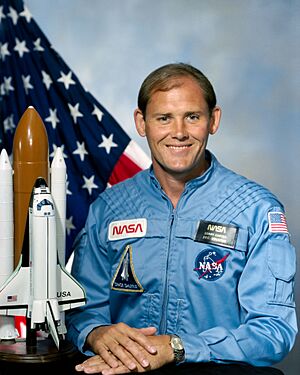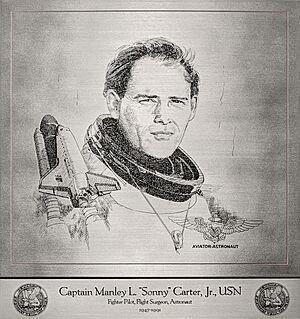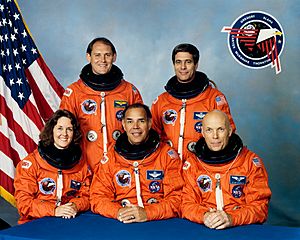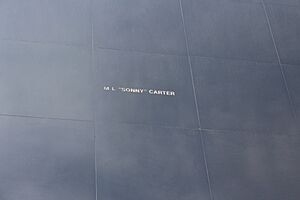Sonny Carter facts for kids
Quick facts for kids
Sonny Carter
|
|
|---|---|

Carter's official NASA portrait, 1984
|
|
| Born |
Manley Lanier Carter Jr.
August 15, 1947 |
| Died | April 5, 1991 (aged 43) Brunswick, Georgia, U.S.
|
| Awards | Air Medal |
| Space career | |
| Rank | Captain, USN |
|
Time in space
|
5d 0h 6m |
| Selection | NASA Group 10 (1984) |
| Missions | STS-33 |
|
Mission insignia
|
|
Manley Lanier "Sonny" Carter Jr. (August 15, 1947 – April 5, 1991) was an amazing American who did many things! He was a chemist, a physician (doctor), a professional soccer player, and a Navy officer and pilot. He was also a test pilot and a NASA astronaut who flew into space on a mission called STS-33.
Contents
Early Life and School Days
Sonny Carter was born on August 15, 1947, in Macon, Georgia. He grew up considering Warner Robins, Georgia his hometown. He went to Lanier High School in Macon and graduated in 1965.
During his high school years, Sonny was very active in the Boy Scouts of America. He even reached the highest rank, becoming an Eagle Scout. This is a big achievement that shows leadership and dedication.
After high school, Sonny went to Emory University in Atlanta. He earned a degree in Chemistry in 1969. Then, he continued his studies and became a Doctor of Medicine (M.D.) in 1973. He completed his first year of medical training at Grady Memorial Hospital in Atlanta.
Sports Star
Sonny Carter was a talented athlete. At Emory University, he played college soccer and ran track. In his final year, he was the captain of the soccer team and was named its most valuable player. He was also an intramural wrestling champion!
While he was in medical school, Sonny played professional soccer. From 1970 to 1972, he played for the Atlanta Chiefs in the North American Soccer League (NASL).
In 1974, Sonny joined the U.S. Navy. He first trained to be a flight surgeon, which is a doctor who takes care of pilots and other flight crew members. After working as a flight surgeon, he went back to flight training himself. On April 28, 1978, he became a Naval Aviator, meaning he was a qualified Navy pilot.
He flew F-4 Phantom fighter jets and even served on the huge aircraft carrier USS Forrestal. In 1982, he attended the famous U.S. Navy Fighter Weapons School, also known as TOPGUN. He then became a test pilot, graduating in 1984. Test pilots fly new or modified aircraft to see how they perform.
Sonny Carter logged 3,000 hours flying planes and made 160 landings on aircraft carriers.
Becoming an Astronaut
In May 1984, NASA chose Sonny Carter to become an astronaut. By June 1985, he was fully qualified as a mission specialist for future Space Shuttle flights. A mission specialist helps with experiments and operations during a space mission.
Space Shuttle Mission STS-33
Sonny Carter was part of the crew for STS-33. This mission launched at night on November 22, 1989, aboard the Space Shuttle Discovery from Kennedy Space Center, Florida. The mission carried important equipment for the Department of Defense and other payloads.
After orbiting Earth 79 times, the five-day mission ended on November 27, 1989. The Discovery landed at Edwards Air Force Base, California. Sonny Carter spent 120 hours in space during this mission.
At the time of his death in April 1991, Sonny was preparing for another space mission, STS-42 Discovery.
Tragic Loss
Sadly, Sonny Carter died on April 5, 1991, in a plane crash. He was traveling for NASA on a commercial airplane, Atlantic Southeast Airlines Flight 2311, which crashed in Brunswick, Georgia. His wife, Dana, and two daughters, Olivia and Meredith, were not on the flight.
His death happened on the same day that the Space Shuttle Atlantis launched on its mission, STS-37.
Honors and Awards
Sonny Carter received many awards for his service and achievements:
- Air Medal
- Meritorious Service Medal
- Navy Achievement Medal
- Meritorious Unit Citation
- NASA Meritorious Service Medal (1988)
- NASA Space Flight Medal (1989)
Lasting Legacy
Because Sonny Carter died while serving NASA, his name was added to the Space Mirror Memorial at the Kennedy Space Center Visitor Complex in Merritt Island, Florida. He was the first person added to the memorial after it was first built.
After his death, NASA's underwater astronaut training facility was named the Sonny Carter Training Facility Neutral Buoyancy Laboratory in his honor. He had helped develop some of the training techniques used there.

In 1989, Emory University honored him by adding him to its Athletic Hall of Fame. Each year, the university holds The Sonny Carter Invitational in his memory. In 1992, he was also inducted into the Georgia Aviation Hall of Fame.
A school in Macon, Georgia, which opened in 1993, was named Sonny Carter Elementary School. Its motto is: "To Challenge the Edge of the Universe."



